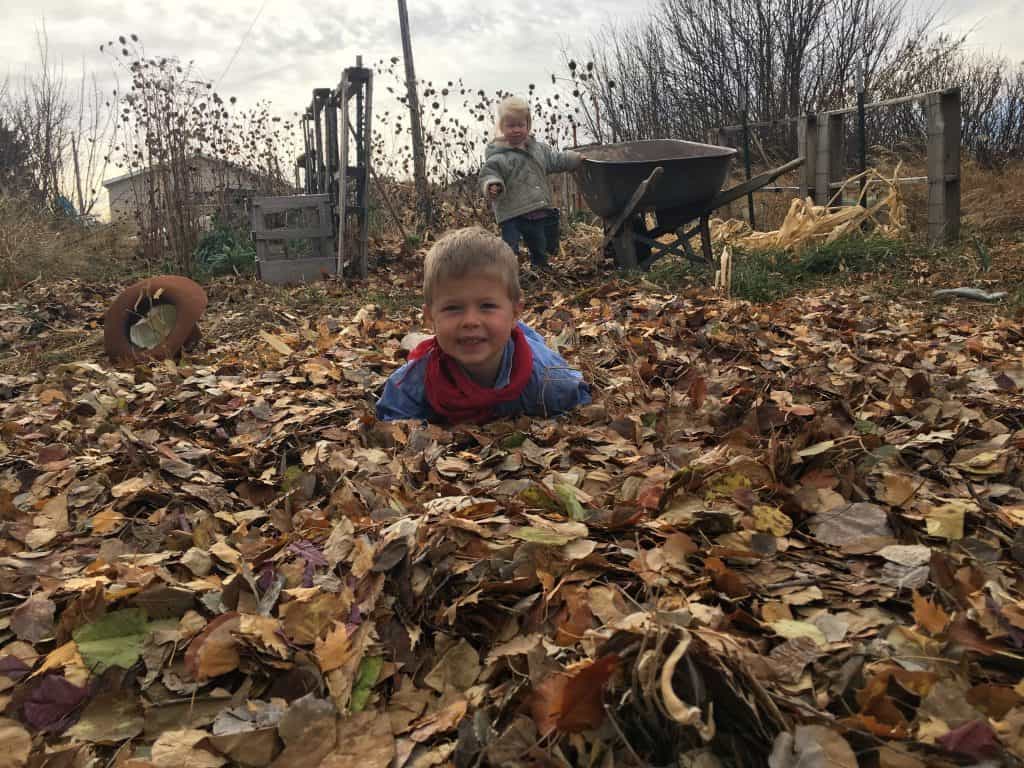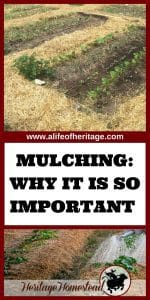Mulching just may be the saving grace of the gardening year. Find out mulching options, what it does for the soil, and the best techniques. Find more gardening tips here!
(Spring and fall mulching information are towards the end. 🙂 )
What if gardening could be made easier by implementing one simple technique?
This technique would make your garden:
• Healthier
• Have fewer weeds
• Be more drought-resistant
And if done properly, your garden would allow you to:
• Spend less time watering
• Weeding
• And fighting pest problems
Seriously, it’s true!
And what would this one technique be?
MULCHING!
There are so many advantages of mulching!
Watch the video on mulching on this page or read the information below or both!
If you like this information, my YouTube channel is full of even more goat information. Please click this link: Delci | A Life of Heritage and subscribe! You can also click this link to watch this information on YouTube: Mulching Video on YouTube
My first years of gardening went like this: begging my husband to till, weeds, 5-foot tall quack grass. And trying desperately to find actual veggies that *really* were planted. Amazingly, I was able to get quite a bit of vegetables, despite my lack of knowledge.
But! There is a better way.
First off, I implemented the “no-till” gardening method. And what a difference! This difference was first noted when there wasn’t a nagging war to get the tilling done in the spring! 😉 But there are so many other benefits! I’ll let the no-till gardening post do all the explaining.
Worried that not tilling will increase your workload? Please keep reading. Fears will be squelched!
I also began to understand why my garden had weeds in the first place. If your garden has weeds, there are very good reasons they are taking root! And you need to know why: Why does my garden have weeds?
There is also a very important tool that all gardeners should implement: cover crops. It has made an amazing difference in my garden!
I also started mulching with straw. Deep straw.
Mulching can encourage slug in your garden. Read about 15 natural ways you can control slugs here.
Several different types of mulching materials can be used.
• Organic mulches (formerly living material)
• Chopped leaves
• Straw or hay (weed-free)
• Grass clippings
• Compost
• Wood chips
• Shredded bark
• Sawdust
• Pine needles
• Paper
• Inorganic mulches
• Gravel
• Stones
• Black plastic
• Geotextiles (landscape fabrics)
Both of the options, organic or inorganic, will keep weeds subdued. And there would be different reasons to choose one or the other.
The Three Cardinal Rules of mulching below!
(Take a look at the free stuff first though 😉 )
Organic material
Advantages of organic mulch:
• Breaks down and decomposes
• Helps to enrich the soil
• Helps to retain moisture in the soil
• Keeps soil cool during the hottest summer days
• Encourages earthworm activity
• Prevents soil compaction
Cons:
• Some mulches, like wood chips and sawdust, deplete nitrogen in the soil
• The mulch retains moisture and can slow the soil from warming up in the spring
• Left touching the stems or bark of a plant or tree, mulch will rot the base of plants and may also encourage rodents to nest in the material
• Mulch may also harbor slugs and snails
Know when to water your garden: The Finger Test
Inorganic material
Advantages of inorganic mulch:
• Black plastic, for instance, will help warm the soil and keep heat-loving plants toasty, even during the night. In fact, the soil will be about 3 degrees warmer
• Keeps produce from rotting
• Keeps produce clean
• Helps to retain moisture in the soil
• With careful care and storage, it can be reused
Cons:
• Rain and water cannot permeate the material, so a soaker hose would be used for watering. Oxygen cannot penetrate through the plastic, so the roots of plants and shrubs can be damaged long term as their roots grow closer to the surface. Shallow roots do not withstand drought or extreme temperatures well.
• Oxygen cannot penetrate through the plastic, so roots of plants and shrubs can be damaged long term as their roots grow closer to the surface. Shallow roots do not withstand drought or extreme temperatures well.
• Plastic is not biodegradable and is made from petroleum products
• Harder to find a place to recycle plastic
• Landscape fabric has some drawbacks as well. There are several things that can go wrong with these fabrics: roots from below can grow up into the fabric and weed seeds can germinate on top of the fabric. Both of these problems will cause the fabric to rip when weeds are pulled or the fabric is removed.
There are a few “cardinal rules” to mulching.
If piles of materials are going to be gathered, it only makes sense that the materials are used to the best of their ability. It makes no sense to put down mulch only to have weeds and grass keep poking their pesky heads up.
Rule #1: weed first. This can be done in several ways. The weeds can be pulled or the tops cut off just below the surface. The tops (before they have gone to seed of course), would be used as mulch and the roots would add organic material to the soil as it breaks down.
My garden area was grass…5-foot tall quack grass to be exact…before I turned it into my garden area. If I don’t pull every last bit of grassroots from my planting areas, there will be 5-foot tall grass growing faster than you can say “summer!” It’s dense, fast-growing, and would choke out any vegetables planted. So I’ve chosen to remove those pesky roots as much as I can.
Rule #2: lay down 4-6 inches of mulch to discourage the growth of new weeds. Another option to consider: lay down cardboard as the first layer and then add mulch on top of the cardboard.
You may also find that many weeds and grass can grow…seemingly endlessly…under any mulch or cardboard. When the mulch is lifted up, the plant can be followed to its beginnings and usually pulled rather easily. But that fact right there shows how desperately weeds and grass want to live another day to see the sunlight one more time.
Rule #3: If there are seeds or perennial weeds or grass in the garden bed, put down a layer of newspaper over the first layer of mulch and then lay several more inches of mulch over the newspaper.
The thickness of the mulch will directly impact how many weeds are able to survive. They lose energy as they are pushing up through the mulch and usually die before they are able to reach the surface.
When using the no-till gardening method, mulching will be the saving grace of any garden.
But it goes beyond just keeping a garden weed-free. Mulch feeds the microorganisms in the soil. And the more abundant life there is down there, the more “food” (mulch) they will need. But the vegetables and soil will be all the healthier from the abundant life, weed-free, moist and cool soil during the hot summer months.
When to Mulch
Fall Mulching
When working with our gardens, it is so very important to work with nature. How do you do that?
Look around at what nature is doing, and replicate that. This will give you and your garden the best possible advantage.
So when does nature mulch?
The fall!!

And the best part is that many people bag up leaves every fall and need them removed from their property. This is when you can step in and take them off their hands!
And that’s exactly what we did. In the picture above you can see that we laid down our newly acquired leaves across our garden area. I’m hoping to pick up more bags after Halloween to finish the rest!
This is what fall mulching does for your garden:
- After the leaves are spread out across the garden area, they will begin to decompose
- The snow, rain, worms, and microorganisms will break down and work the leaves into the soil all winter long
- These leaves are also food for the microorganisms
- They will also protect the ground from erosion, and deep freezes
- And will discourage seed germination and weed growth in the spring
Spring Mulching
Mulch can also be laid down during planting and on all the known pathways. And as the plants grow, it can be added to and moved closer to the rows.
Mulching in the spring also adds to the food source for the microorganisms. Don’t ever forget their importance to the health of your soil!
Spring is when all of life is bursting to life and weeds are resilient and have a much earlier start than our gardens do, so the fall mulch will help with keeping the weeds subdued and the weed seeds from germinating.
But the spring layer of mulch will be what your garden needs to stop those weeds that can poke through anything.
Retaining moisture and keeping the ground cool during the hottest of summer months is also a huge advantage of putting down more mulch in the spring.
Just remember, our earth is modest and can’t handle being naked. For the sake of the soil in your garden, cover it.



